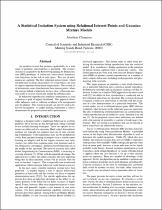 ResearchSpace
ResearchSpace
Statistical imitation system using relational interest points and Gaussian mixture models
JavaScript is disabled for your browser. Some features of this site may not work without it.
- ResearchSpace
- →
- Research Publications/Outputs
- →
- Conference Publications
- →
- View Item
| dc.contributor.author |
Claassens, J

|
|
| dc.date.accessioned | 2010-07-12T13:46:37Z | |
| dc.date.available | 2010-07-12T13:46:37Z | |
| dc.date.issued | 2009-11 | |
| dc.identifier.citation | Claassens, J. 2009. Statistical imitation system using relational interest points and Gaussian mixture models. 20th Annual Symposium of the Pattern Recognition Association of South Africa (PRASA), Stellenbosch, South Africa, 30 November-01 December 2009, pp 121-126 | en |
| dc.identifier.isbn | 978-0-7992-2356-9 | |
| dc.identifier.uri | http://hdl.handle.net/10204/4059 | |
| dc.description | 20th Annual Symposium of the Pattern Recognition Association of South Africa (PRASA), Stellenbosch, South Africa, 30 November-01 December 2009 | en |
| dc.description.abstract | The author proposes an imitation system that uses relational interest points (RIPs) and Gaussian mixture models (GMMs) to characterize a behaviour. The system's structure is inspired by the Robot Programming by Demonstration (RDP) paradigm. The model extracted can also be used to identify a behaviour. Reproduction is done through nonlinear optimization using a variant of the Nelder-Mead algorithm which produces a highly probable path given the behaviour model. The system was successfully demonstrated on a line drawing task. Although simple, it illustrates that the imitation system will generalize when accuracy in a task is not required and satisfy precise requirements when identified. A great many behaviours would require similar abilities as the example task. Given that reproduction merely requires the parameters of each GMM and the RIPs with their parameters, it is clear that the imitation system is effectively a behaviour compression system. With the first example the storage space amounts to around 100 floating point double precision variables. This allows a designer to store many taught behaviours in a single system. For future work the Phantom haptics input device will function as a master to a slave manipulator (such as a Barrett Whole Arm Manipulator). A vision system will be added to capture fiducial locations. The author concludes that the scheme’s major weaknesses are the imprecise stopping condition of the EM algorithm and the fact that RIPs are not continuous. A continuous spatial constraint which captures regions of trajectories would produce smoother reproduction results. These problems are currently being investigated | en |
| dc.language.iso | en | en |
| dc.publisher | PRASA 2009 | en |
| dc.subject | Statistical imitation | en |
| dc.subject | Manipulator planning | en |
| dc.subject | Gaussian mixture models | en |
| dc.title | Statistical imitation system using relational interest points and Gaussian mixture models | en |
| dc.type | Conference Presentation | en |
| dc.identifier.apacitation | Claassens, J. (2009). Statistical imitation system using relational interest points and Gaussian mixture models. PRASA 2009. http://hdl.handle.net/10204/4059 | en_ZA |
| dc.identifier.chicagocitation | Claassens, J. "Statistical imitation system using relational interest points and Gaussian mixture models." (2009): http://hdl.handle.net/10204/4059 | en_ZA |
| dc.identifier.vancouvercitation | Claassens J, Statistical imitation system using relational interest points and Gaussian mixture models; PRASA 2009; 2009. http://hdl.handle.net/10204/4059 . | en_ZA |
| dc.identifier.ris | TY - Conference Presentation AU - Claassens, J AB - The author proposes an imitation system that uses relational interest points (RIPs) and Gaussian mixture models (GMMs) to characterize a behaviour. The system's structure is inspired by the Robot Programming by Demonstration (RDP) paradigm. The model extracted can also be used to identify a behaviour. Reproduction is done through nonlinear optimization using a variant of the Nelder-Mead algorithm which produces a highly probable path given the behaviour model. The system was successfully demonstrated on a line drawing task. Although simple, it illustrates that the imitation system will generalize when accuracy in a task is not required and satisfy precise requirements when identified. A great many behaviours would require similar abilities as the example task. Given that reproduction merely requires the parameters of each GMM and the RIPs with their parameters, it is clear that the imitation system is effectively a behaviour compression system. With the first example the storage space amounts to around 100 floating point double precision variables. This allows a designer to store many taught behaviours in a single system. For future work the Phantom haptics input device will function as a master to a slave manipulator (such as a Barrett Whole Arm Manipulator). A vision system will be added to capture fiducial locations. The author concludes that the scheme’s major weaknesses are the imprecise stopping condition of the EM algorithm and the fact that RIPs are not continuous. A continuous spatial constraint which captures regions of trajectories would produce smoother reproduction results. These problems are currently being investigated DA - 2009-11 DB - ResearchSpace DP - CSIR KW - Statistical imitation KW - Manipulator planning KW - Gaussian mixture models LK - https://researchspace.csir.co.za PY - 2009 SM - 978-0-7992-2356-9 T1 - Statistical imitation system using relational interest points and Gaussian mixture models TI - Statistical imitation system using relational interest points and Gaussian mixture models UR - http://hdl.handle.net/10204/4059 ER - | en_ZA |





